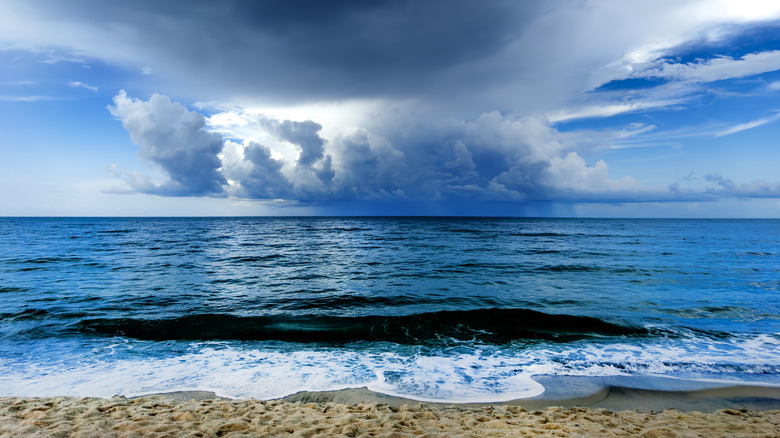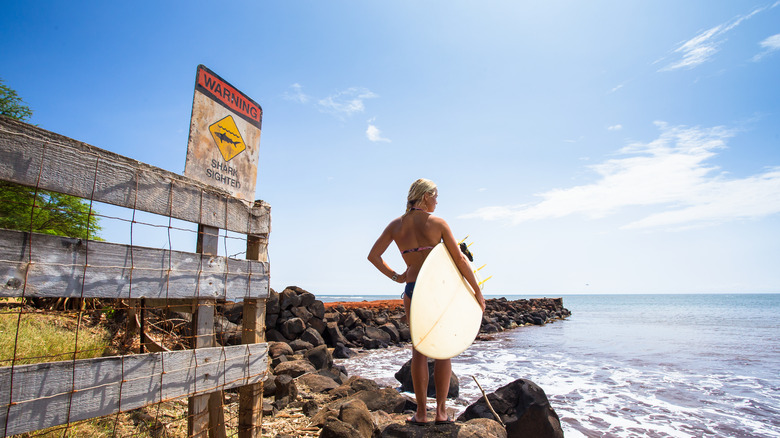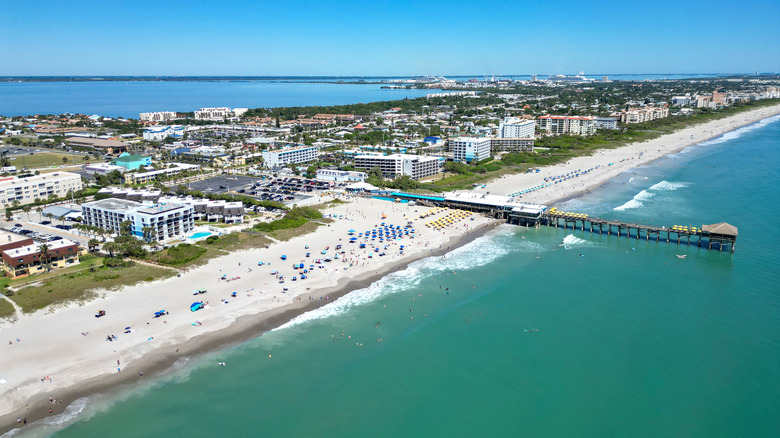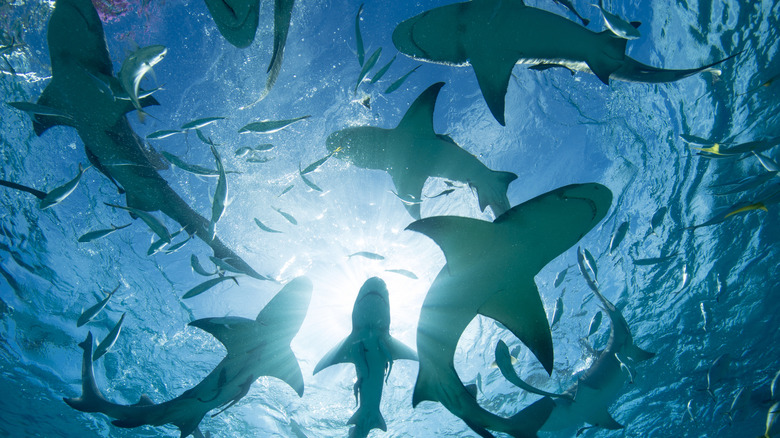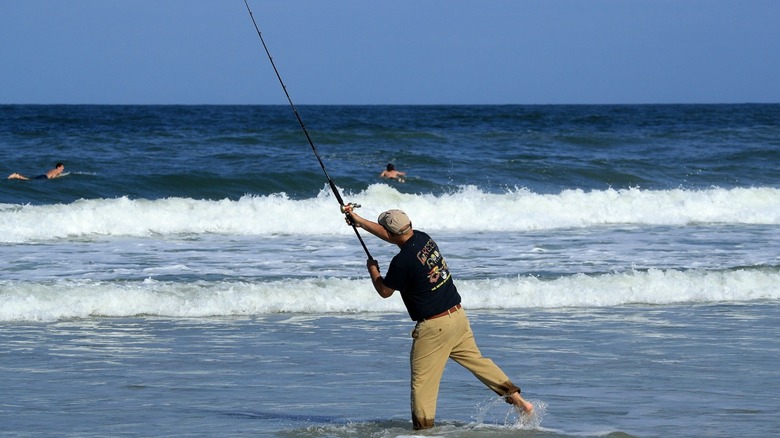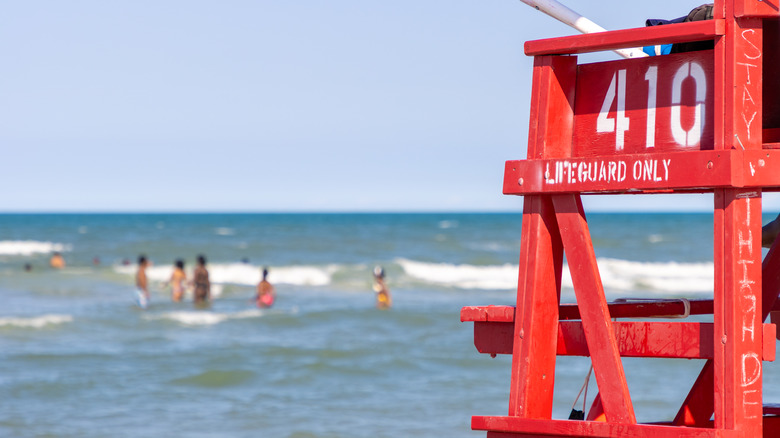These 5 Destinations Have Had The Most Shark Attacks In All Of Florida
Florida is the number one shark attack destination in the world; this is a statistical fact. Despite this, it's a paradise for beachgoers, surfers, and marine life enthusiasts — millions of tourists visit Florida's 8,000 miles of golden, sunny coastline every year, and 40% of all visitors hit the beach (per USA Today). While shark attacks are rare, and fatalities even rarer, of the average 100 annual shark attacks globally, Florida consistently leads the world in the number of incidents.
The chances of a shark attack are 1 in 11.5 million. You actually have a higher chance — 1 in 3 million — of dying from food poisoning or even getting struck by lightning. However, there are some things you can do to protect yourself if you see a shark while swimming. Avoid swimming at dawn or dusk, when sharks are most active as they hunt for food. Stick to groups; sharks are more likely to target individuals who are alone. Avoid wearing shiny jewelry, and steer clear of schools of fish or diving seabirds. Do not enter the water if you're bleeding, and always respect shark warning signs.
According to the Florida Museum of Natural History's International Shark Attack File, certain areas in Florida have seen more of both provoked and unprovoked shark attacks than others. If you're curious about where these encounters happen most frequently, here's a comprehensive look at the five most shark-infested destinations in Florida that have recorded the highest number of shark attacks: Volusia, Brevard, Palm Beach, St. Johns, and Duval.
Volusia County: Shark bite capital
Volusia County, situated on Florida's east coast, has some of the state's most popular beaches, including the infamous Daytona Beach and New Smyrna Beach. However, this hotspot is not only known for its sun, surf, and sand — it has also earned the dishonorable title of the "Shark Bite Capital of the World." Volusia County has recorded more attacks — a total of 351 unprovoked attacks since 1882 — than any other place in Florida and, indeed, the whole world.
This high number of shark incidents is largely due to its geography and the behaviors of both sharks and humans. New Smyrna Beach, in particular, is a favorite among surfers. Unfortunately, with their boards and paddling movements, surfers are often mistaken for prey. In fact, 42% of shark bite victims were engaging in surfing or another type of board sport at the time of their attack (per News-Press). The nearby Ponce Inlet, a major channel with a deep dredge that connects the Atlantic Ocean to the Intracoastal Waterway, is a favorite feeding ground for sharks due to its abundance of baitfish.
Despite the high number of incidents, most shark attacks in Volusia County are minor, with the majority involving small bites — known as "nip-and-runs" — that don't result in serious, life-threatening injury. The sharks commonly found in these waters, such as the piscivorous blacktip and spinner, are generally not aggressive toward humans unless provoked. Nevertheless, the sheer number of encounters has cemented Volusia County's reputation as the epicenter of Florida's shark activity.
Brevard County: Surfing hub with shark encounters
Just south of Volusia County lies Brevard County, another area with many shark attacks. Brevard is famous for its surfing culture, particularly around Cocoa Beach, which was recently named Florida's best beach town for surfing. For a city with a population of merely 12,000 people, Cocoa Beach draws over 2.5 million tourists every year! Brevard's long stretch of coastline and consistent waves make it a prime destination for water sports, but that very quality also makes it a hotspot for shark encounters, with 158 attacks since 1882.
The waters off Brevard are home to around 18 shark species, including blacktip, Atlantic sharpnose, and spinner, with the occasional sighting of a great white (one of the biggest shark species ever). Sharks are particularly drawn to Brevard during August and September, when schools of mullet, anchovies, and herrings begin migrating along the east Central Florida coasts. Between December and March, the annual migration of blacktip, spinner, bull, and hammerhead sharks also contributes to higher numbers of shark encounters.
One notable aspect of shark attacks in Brevard County is that they are often associated with the sandbar, where many surfers catch waves. Sharks frequent these areas in search of their natural food items (not humans!), and the attacks happen due to mistaken identity. It's important to remember that less than 1% of Florida's shark attacks are fatal and that from the hundreds of different shark species that exist in the world, none consider humans as their food source.
Palm Beach County: Clear waters and shark sightings
Palm Beach County, located further south on Florida's Atlantic coast, also has its fair share of shark sightings. With 83 attacks since 1882, Palm Beach is third on the list of the most dangerous beaches in Florida you'll want to avoid on your next trip. The county's beaches, such as those in Jupiter and Singer Island, are known for their clear waters and extensive coral reefs, which make them very popular for snorkeling, scuba diving, and other water activities. Of course, with these same features also come sharks.
A key factor contributing to shark activity in Palm Beach is the Gulf Stream, a powerful ocean current that brings warm, nutrient-rich waters close to shore. This current attracts a variety of marine life, including sharks, which follow the schools of fish carried by the stream. The Gulf Stream is also responsible for the county's clear water and flourishing coral reefs. Palm Beach inlets and estuaries, such as the Jupiter Inlet (a popular dive site), are also areas that sharks frequent for food.
One recent shark sighting was of Breton, a 13-foot, 1,437-pound great white who came for a very rare splash at Juno Beach. He is a tagged shark monitored by OCEARCH scientists — you can keep up with Breton's regularly-updated international whereabouts here. While Palm Beach County has seen its share of shark attacks, like in other areas of Florida, the majority are non-fatal and involve smaller species that pose little threat to humans.
Duval County: Jacksonville's sharky waters
Duval, located north of Volusia County, has had 46 unprovoked shark attacks since 1882. The uptick of cases on Florida's north coast shows an alarming trend. "What we found now is that with water temperatures rising and the oceans getting warmer, these sharks are going farther north than they did before, because the water is warmer farther north now ... They're also not coming as far south to Florida like they used to," explains Gavin Naylor, director of the Florida Program for Shark Research (via Tampa Bay Times).
This north Florida county is home to the city of Jacksonville, with popular spots like Jacksonville Beach, known for surfing, fishing, and swimming opportunities. The presence of the St. Johns River, which empties into the Atlantic Ocean, plays a role in the area's shark activity. The river creates a brackish environment where fresh and saltwater mix, which bull sharks, in particular, tend to wander into in search of food, to give birth, or to rid themselves of parasites.
Bull, blacktip, and spinner sharks frequent the waters of Duval County, but while the number of attacks here is lower than in other parts of Florida, the area's popularity for water sports and fishing increases the likelihood of encounters. More humans and more sharks equal more bites. Once a shark realizes they accidentally bit a human — not a fish — they release their bite. You have a higher chance of getting killed by a mosquito, hippo, or deer!
St. Johns County: A growing bite
Rounding out the list with 45 shark attacks since 1882 is St. Johns County, located just south of Duval County. This is another area in Florida where you'd most likely be attacked by a shark, with recorded numbers higher than in Mexico (total: 42), the Bahama Islands (total: 34), and the Fiji Islands (total: 23). The county's beaches, including St. Augustine Beach and Ponte Vedra Beach, are popular destinations for both locals and tourists. With a growing population and an increasing number of visitors, the likelihood of shark encounters has also risen.
From 300-pound bull sharks and 400-pound lemon sharks to blacktip shark pups, small and big sharks hang around St. Johns. These sharks are particularly active during the spring and summer months as they move inshore in search of their natural prey — coinciding with the most popular times of the year when people swim, surf, and hang out in those warm, shallow Florida waters.
The reality is that sharks themselves have an astronomically higher chance of ending up in a bowl of shark fin soup than for a human to be injured or killed by a shark. While 100 million sharks die every year because of the fishing industry, fewer than 10 people die from shark bites every year (per Florida Fish and Wildlife Conservation Commission). Humans are not on a shark's menu, so don't let galeophobia (fear of sharks) deter you from hitting Florida's beautiful beaches and having a good time — just remember these safety tips to protect yourself from sharks.
